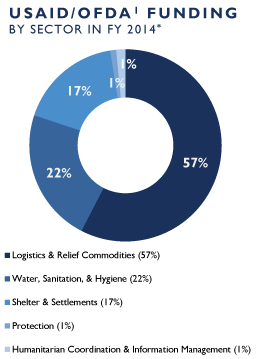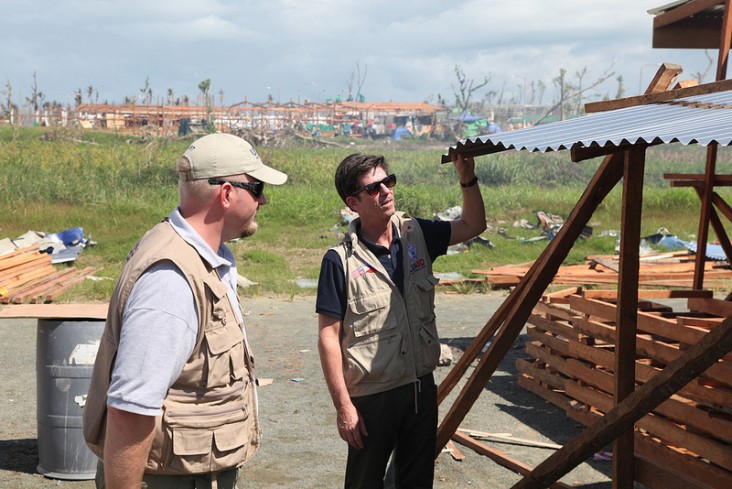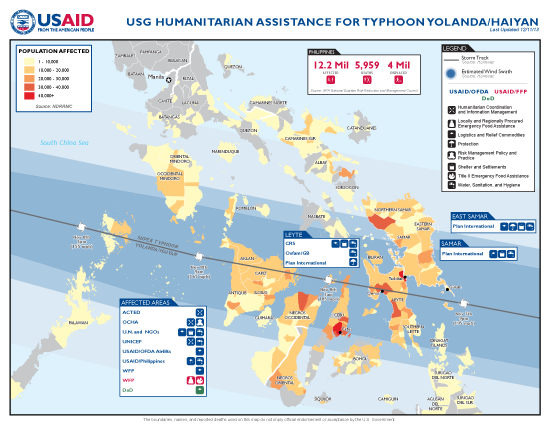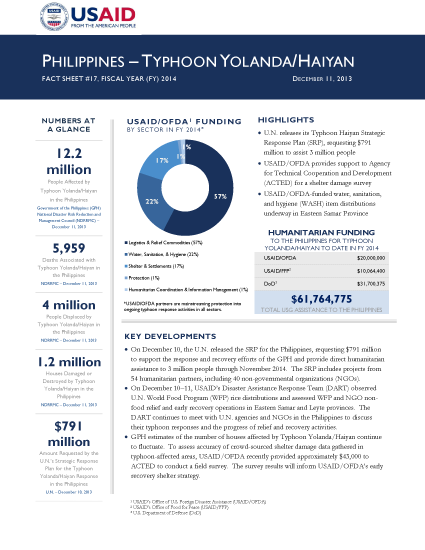- What We Do
- Agriculture and Food Security
- Democracy, Human Rights and Governance
- Economic Growth and Trade
- Education
- Ending Extreme Poverty
- Environment and Global Climate Change
- Gender Equality and Women's Empowerment
- Global Health
- Water and Sanitation
- Working in Crises and Conflict
- Disaster Assistance
- Political Transition Initiatives
- Conflict Mitigation and Prevention
- Countering Violent Extremism
- Disaster Risk Reduction
- Peacebuilding and Reconciliation
- Providing Safe & Secure Environments for Development
- Recovering From Crisis
- Resilience
- Tech Challenge for Atrocity Prevention
- World Humanitarian Day
- U.S. Global Development Lab
December 11, 2013
Numbers At A Glance
12.2 million
5,959
4 million
1.2 million
$791 million
Humanitarian Funding:
To The Philippines For Typhoon Haiyan/Yolanda To Date In FY2014:

| USAID/OFDA | $20,000,000 |
| USAID/FFP | $10,064,400 |
| DoD | $31,700,375 |
| TOTAL | $61,764,775 |
Typhoon Haiyan / Yolanda Fact Sheet #17 - 12/11/2013 ![]() (pdf - 209k)
(pdf - 209k)
Highlights
U.N. releases its Typhoon Haiyan Strategic Response Plan (SRP), requesting $791 million to assist 3 million people.
USAID/OFDA provides support to Agency for Technical Cooperation and Development (ACTED) for a shelter damage survey.
USAID/OFDA-funded water, sanitation, and hygiene (WASH) item distributions underway in Eastern Samar Province.
Key Developments
On December 10, the U.N. released the SRP for the Philippines, requesting $791 million to support the response and recovery efforts of the GPH and provide direct humanitarian assistance to 3 million people through November 2014. The SRP includes projects from 54 humanitarian partners, including 40 non-governmental organizations (NGOs).
On December 10–11, USAID’s Disaster Assistance Response Team (DART) observed U.N. World Food Program (WFP) rice distributions and assessed WFP and NGO non-food relief and early recovery operations in Eastern Samar and Leyte provinces. The DART continues to meet with U.N. agencies and NGOs in the Philippines to discuss their typhoon responses and the progress of relief and recovery activities.
GPH estimates of the number of houses affected by Typhoon Yolanda/Haiyan continue to fluctuate. To assess accuracy of crowd-sourced shelter damage data gathered in typhoon-affected areas, USAID/OFDA recently provided approximately $43,000 to ACTED to conduct a field survey. The survey results will inform USAID/OFDA’s early recovery shelter strategy.
AGRICULTURE AND FOOD SECURITY
- Through the SRP, the Food Security and Agriculture Cluster (FSAC)—the coordinating body for food security and agriculture activities in the Philippines—is requesting $188 million to target 3 million typhoon-affected people with food assistance and agriculture support through November 2014. The funding will support the cash-for-work, food-for-work, fisheries, and agriculture activities of 19 cluster partners.
- The DART food officer visited WFP rice distributions conducted by several NGO partners in Leyte and Samar provinces on December 10–11. WFP is targeting approximately 1 million beneficiaries with 10,000 metric tons (MT) of rice across 64 municipalities in Leyte, Panay, and Samar islands by the end of December. The DART food officer noted no major concerns at distribution sites. Beneficiaries are receiving 5 kilograms of rice per person for a two-week period, as well as blanket supplementary food for children under the age of five.
- On December 11, the U.N. Food and Agriculture Organization (FAO) reported that Typhoon Yolanda/Haiyan most affected small-scale fishers in the Philippines, damaging or destroying tens of thousands of small boats, as well as fishing gear and critical infrastructure, such as jetties and landing ports, onshore ice and cold storage facilities, boat repair and maintenance facilities, processing factories, and markets. FAO is currently working with the GPH to prepare a recovery and reconstruction plan for all agriculture subsectors, including fisheries, and is requesting an initial $5 million to restore the livelihoods of fishers and coastal communities affected by Typhoon Yolanda/Haiyan.
- To date, USAID/FFP has provided approximately $10 million through WFP to meet the food needs of typhoon-affected populations, including $7.75 million for the local procurement of rice and high-energy biscuits, as well as cash and voucher transfers and cash-for-work activities.
LOGISTICS AND RELIEF COMMODITIES
- The DART visited WFP distribution sites in Leyte Province on December 10–11 to assess non-food relief and early recovery operations and reported that USAID-provided relief goods continue to reach affected communities. The DART noted that debris removal is advancing rapidly, electricity is being restored, and markets are functioning in many typhoon-affected areas.
- The DART also observed Plan International’s USAID/OFDA-funded distribution of WASH items, including 50 boxes of collapsible water containers, 10 toilet slabs, and 10 plastic toilet bowls in MacArthur municipality in Eastern Samar Province. Plan International will continue distributing USAID/OFDA-provided WASH items in the coming days to outlying areas.
- As of December 8, the Logistics Cluster had facilitated the transport of approximately 4,400 MT of relief cargo via sea, road, and air. Additionally, the U.N. Humanitarian Air Service had transported 1,030 humanitarian passengers and 6 MT of cargo on nearly 160 flights to 18 locations.
- USAID/OFDA has provided nearly $10.4 million to date for logistics support and relief commodities, including approximately $3.3 million for USAID/OFDA commodity airlifts, $2.1 million for the provision of emergency relief commodities, and $5 million for logistics operations support.
PROTECTION
- The Protection Cluster recently reported that GPH Department of Social Welfare and Development (DSWD) representatives are focused on strengthening coordination with cluster members on protection issues. Activities focusing on child protection are underway—including messaging to parents and community members on child protection issues, family tracing activities, and training for approximately 200 GPH officials.
- U.N. gender-based violence (GBV) coordinators are working with DSWD representatives in typhoon-affected areas to mainstream GBV issues into humanitarian response activities, according to the Protection Cluster. The GBV Sub-Cluster is undertaking a mapping exercise to assess any GBV-related humanitarian gaps and has begun protection messaging through radio stations in affected areas.
- The GPH has deployed additional female police officers to typhoon-affected areas and initiated the training of Tacloban police forces on protection issues. DSWD is coordinating with the police, the Armed Forces of the Philippines, and other relevant government agencies to increase awareness and outreach on protection issues.
- The GPH Department of Health, with support from the U.N. World Health Organization (WHO), recently trained 25 medical professionals from government agencies, professional associations, universities, and community organizations on WHO-recommended psychological first aid techniques to support typhoon survivors. Using a train-the-trainer approach, the Filipino psychologists, physicians, and psychiatrists who participated in the training will teach others in their communities to perform the first aid, improving access to basic psychosocial support for affected populations.
SHELTER AND SETTLEMENTS

- Affected housing numbers continue to fluctuate. At present, the GPH reports that the typhoon damaged or destroyed nearly 1.2 million houses, of which approximately 594,000 were destroyed. In Eastern Visayas Region—where USAID/OFDA shelter operations are ongoing—the typhoon reportedly destroyed more than 277,000 houses, with nearly 242,000 houses experiencing partial damage.
- Shelter Cluster partners have provided emergency shelter materials, including plastic sheeting, tents, tools, and rope, to more than 122,000 households and support for shelter self-recovery, such as more substantial shelter repair kits, cash, and construction materials, including corrugated galvanized iron sheeting, to approximately 22,400 people. Overall, the majority of households have started to rebuild their damaged or destroyed homes. The U.N. reports that the availability of housing supplies, particularly corrugated galvanized iron sheeting, remains inconsistent in affected areas.
- The GPH recently released approximately $5.3 million to support and extend the Housing Materials Assistance program, which supports permanent shelter assistance for families that do not require resettlement. Each family with a partially damaged home will receive approximately $113.
- In recent years, remote sensing technology and open data sharing platforms have allowed rapid damage assessments and imagery analysis to provide information in critical areas. USAID/OFDA is providing approximately $43,000 to ACTED to validate the accuracy of crowd-sourced shelter damage assessments following the typhoon. Findings from the initiative will help facilitate the use of crowd-sourced damage assessments in more formal settings and link crowd-sourced assessments with other rapid assessment initiatives, speeding up the flow of information from shelter assessments during this and other emergency responses and helping to validate the results of various assessments.
INTERNATIONAL ASSISTANCE
- On December 10, the U.N. released the SRP for Typhoon Yolanda/Haiyan in the Philippines, requesting $791 million to provide direct humanitarian assistance to 3 million people through November 2014—one year after the disaster occurred. The SRP, which includes projects from 54 humanitarian partners, including 14 U.N. agencies and 40 NGOs, complements the GPH’s Yolanda Recovery and Rehabilitation Plan, expected to be released in coming weeks. The SRP targets 3 million people with food security and agriculture assistance, 3 million people with WASH support, 500,000 people with emergency shelter assistance, and 400,000 people with early recovery and livelihoods support. In addition, the U.N. estimates that more than 7 million people will benefit from support to health services and up to 5 million people will benefit from protection-related activities.









Comment
Make a general inquiry or suggest an improvement.